Ryan Hall's Blog, page 232
July 20, 2016
U.S. Olympians to Compete in New TrackTown Summer Series Meet
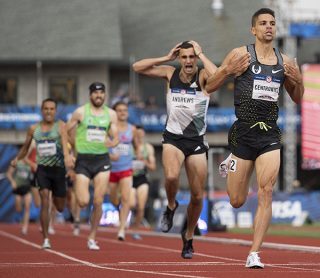
Matthew Centrowitz won the 1,500-meter run at the U.S. Olympic Trials on July 10 at Hayward Field in Eugene, Ore. Photo: Jeff Cohen
Seventeen American athletes who punched their ticket to the Rio Olympics at the U.S. Olympic Track & Field Trials plan to return to Hayward Field next week to compete in the inaugural TrackTown Summer Series.
The TrackTown Summer Series, presented by Beynon Sports Surfaces, is designed to provide top American track and field athletes with a unique opportunity to compete on U.S. soil during the summer months.
The meet will be held at Hayward Field at 7 p.m. on Friday, July 29. It will be televised live on ESPN.
The scored competition features four teams of 36 athletes each, split evenly between men and women, representing the cities of Portland, Ore., New York City, San Francisco and Philadelphia. Competitors will battle for prize money and additional benefits in excess of a half-million dollars.
“We’re excited that Hayward Field will be the stage for many of these athletes before they embark on their Olympic journey to Rio,” said TrackTown USA CEO Michael Reilly. “We believe the team-scoring aspect will provide a tremendous opportunity for both fans and athletes to engage in a great competition.”
Several Olympic athletes scheduled to compete in the TrackTown Summer Series were chosen in an historic eight-round draft on June 25. The four teams are in the process of finalizing rosters this week with the addition of 20 athletes per squad.
One of the U.S. athletes who will compete in both the TrackTown Summer Series and Rio Olympics is University of Oregon alum Matthew Centrowitz, a 2012 Olympian and reigning World Indoor champion in the 1,500 meters. Centrowitz won the 1,500m at the Trials with a meet record of 3 minutes, 34.09 seconds. He plans to run the 800m at the TrackTown Summer Series against a stacked field.
“First of all, I’m thrilled, obviously to make the Olympic team,” said Centrowitz, who competes for Portland-based Nike Oregon Project. “As a former Duck, I noticed a huge boost in special ovations at the Trials, and I’m expecting that same support when I return to Hayward for the TrackTown Summer Series.”
Centrowitz and Brittney Reese, the reigning 2012 Olympic gold medalist and six-time World Champion in the long jump, were the top overall picks of the athlete draft by Team New York City.
“That was really cool,” Centrowitz said. “I got a text from a friend even before I noticed it on Twitter. To be the first pick in the first draft ever, and to go to a team representing one of my favorite cities, it couldn’t have gone down any better.”
2016 Olympians entered in the inaugural TrackTown Summer Series are:
PHILADELPHIA – Phyllis Francis (400m), Brenda Martinez (800m), Ben Blankenship (1,500m), Michelle Lee Ahye (100m, Trinidad & Tobago)
PORTLAND – Kate Grace (1,500m), Ricky Robertson (high jump), Will Claye (triple jump)
SAN FRANCISCO – Erik Kynard (high jump), Shannon Rowbury (1,500m), Robby Andrews (1,500m), Melissa Bishop (800m, Canada)
NEW YORK CITY – Matthew Centrowitz (800m), Brittney Reese (long jump), Donn Cabral (3,000m steeplechase), Emma Coburn (1,500m), Jeff Porter (110m hurdles), Felisha Johnson (shot put)
The post U.S. Olympians to Compete in New TrackTown Summer Series Meet appeared first on Competitor.com.
Out There: Just Read the Damn Article

“It’s all about the headline.”
When I first started writing, my handlers hammered this notion into my head repeatedly. Sure, the content of an article is important, they said, but it doesn’t matter much if it doesn’t have a shocking, droll, or otherwise attention-grabbing headline to get readers to open the magazine or click on the link.
Over the years, however, the function of a headline has changed from getting people in the door to becoming the main attraction itself. In today’s scroll-through-Twitter society, most people don’t read past the headline. Sometimes they read the one-sentence summary below the headline (known in the biz as a lede), but rarely do they click on the link or read the article itself.
Lest you think I’m exaggerating, a new study has discovered that 59 percent of links shared on social media have never been clicked: In other words, most people appear to share news without actually reading it. We take a summary-of-a-summary glimpsed on Twitter or Facebook as fact, and we’re all the dumber for it.
Take my husband, for example. A few months ago, he saw a story in his Facebook feed titled “Dark Chocolate Boosts Exercise Performance.”
“Look at this, babe,” he said with glee. “Chocolate will make me faster!”
This explains why Neil is currently on his third brownie of the day. He has yet to set a PR this season. (Imagine that!)
Had he actually read the story, he’d know that a British study on chocolate consumption was conducted on nine cyclists. Nine. That’s hardly enough data to make the sweeping generalization of “Chocolate Boosts Exercise Performance.” Yet that’s the headline, because a world where chocolate is an ergogenic aid is a world we all want to live in, dammit.
And so it goes for almost every headline these days. “Running Will Kill You,” the headlines blare, justifying your Uncle Mel’s decision to remain firmly on the couch, smugly anticipating your impending demise. “Red Wine Is a Health Food,” we cite as we pour ourselves a second (okay, fine, fourth) glass. “Pasta is an Evil Gluten Monster,” unless a pasta company sponsors a study this week, in which case “Athletes Should Eat Pasta Every Day.” “Beer Aids Marathon Recovery,” people say smartly as they order a pint, oblivious to the caveat that it’s non-alcoholic beer that’s proven to have regenerative properties.
Don’t be that guy. Read the damn article. Follow the sources. Get the full story.
But if we insist on continuing down this path of sharing without reading, I’d like to propose a few headlines and ledes that I think will really take off on social media:
Beet Industry Admits Product Tastes Disgusting
“We targeted runners because they’ll eat anything if you tell them it’s ‘performance-enhancing,’ industry insider confesses.”
Pokemon GO Tricks Millions Into Running Marathon
“People who ‘hate running’ and ‘have bad knees’ will sprint nonstop between strategically placed Pikachus; public health officials declare covert intervention for obesity a success.”
National Park Service to Outlaw Horse Poop on Trails
“Move comes after runners begin dropping deuces mid-trail in protest.”
New iPhone Detects, Averts Post-Race Humblebragging
“App sends small taser shocks to runners who
backdoor brag
, preventing millions of annoyed eye rolls worldwide.”
White Spandex Shorts Sap Male Athletes Of Strength
“Experts say men should not wear garment–not during races, not to yoga, not ever.”
Kenyan Athletes Warm Up By Jogging to Rio Olympics
“Team foregoes private jet from Africa, claiming flight would be ‘too slow.'”
* * *
About The Author:
Susan Lacke does 5Ks, Ironman Triathlons and everything in between to justify her love for cupcakes (yes, she eats that many). Susan lives and trains in Salt Lake City, Utah with three animals: A labrador, a cattle dog, and a freakishly tall triathlete husband. She claims to be of sound mind, though this has yet to be substantiated by a medical expert. Follow her on Twitter: @SusanLacke
The post Out There: Just Read the Damn Article appeared first on Competitor.com.
Video: Watch Joe Gray Fly Down Pikes Peak’s Barr Trail
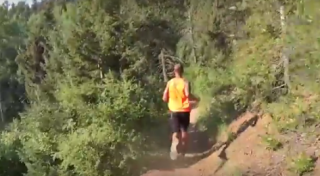
Joe Gray, one of America’s top trail runners for much of the past decade, decisively won the 12.6-mile Barr Trail Mountain Race along the lower flanks of Pikes Peak in Manitou Springs, Colo., on July 17. In this video, shot by Mark Tatum of the trail running site MUTWild.com, Gray, a Merrell-sponsored athlete, flies down Barr Trail on the switchbacks just above No Name Creek. Gray, a 10-time U.S. champion with many top-10 international race finishes, won the Barr Trail Mountain Race in 1:30:0, running roughly 7:09/mile pace (which is quite fast for running downhill on singletrack trails). Tatum was shooting with a GoPro Hero Silver mounted to a Feiyu hand-held gimbal device.
The post Video: Watch Joe Gray Fly Down Pikes Peak’s Barr Trail appeared first on Competitor.com.
Video: Condom Company Develops Experimental Athletic Apparel
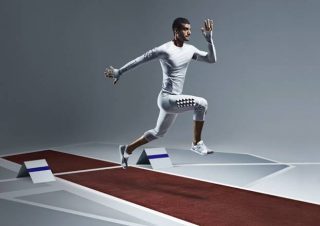
Ansell, a global leader in protection solutions and the makers of SKYN® Condoms, an innovative brand of premium condoms and lubricants, has developed SkynFeel Apparel.
In what can only fall into the category of “you have to see this to believe it,”—the parent company of Skyn Condoms has been working on experimental athletic apparel. Ansell, a global leader in protection solutions and the makers of Skyn Condoms, says its new one-of-a-kind long-jump suit for track athletes is inspired by “biomimicry” utilizes thin, ultra-soft condom material. “Like a second skin with inspiration from the dragonfly’s wings, the SkynFeel Apparel is design to minimize body limitation and give extra airtime to the athlete,” the company says in a release.
“The Skyn brand has innovation woven into its DNA,” says Jeyan Heper, president and general manager of the Sexual Wellness Global Business Unit at Ansell. “In the world of competitive sports, athletes look for every advantage, and we knew our SkynFeel condom material was revolutionary in our own industry, therefore we turned to the world of performance athletics and decided to conduct an experiment in apparel. We wanted to allow ourselves to think differently, outside of our own condom box.”
To create the unusual concept garment, Skyn Condoms partnered with fashion designer Pauline Van Dongen, whose wearable technology creations have won wide acclaim. “Experiments like this can point the way to the future,” Van Dongen says. “For me, SkynFeel Apparel is about challenging the status quo, trying something totally new, daring to innovate, imagine and inspire.”
The post Video: Condom Company Develops Experimental Athletic Apparel appeared first on Competitor.com.
July 19, 2016
4 Bodyweight Exercises You Can Do Anywhere
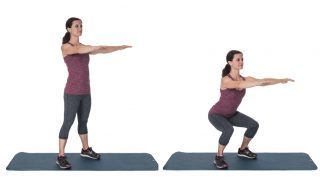
Runners are adept at making excuses for why they can’t strength train: There’s either not enough time in the day, no gym access, or they’re afraid to put on bulk. All of these excuses are weak! In as little as 10–15 minutes, three to four times a week, you can become a stronger, more balanced athlete, improve your muscle tone and also decrease the likelihood of annoying overuse injuries.
The following four bodyweight exercises can be done anywhere, and the only equipment you’ll need to invest in is a stability ball. Perform this routine three to four times a week. Start with one to two sets and build up to three to four over the course of a month. Move through the exercises quickly but take two to three minutes of recovery between sets. The key is consistency: Pick the days you plan to strength train and stick to it. No excuses!
Photos: Oliver Baker
Photo Gallery
1 of {count}
Back to Start
View Larger Image

Air Squats
Stand with your feet shoulder-width apart and your heels firmly planted on the floor. Put your hands straight out in front of you and begin lowering your body into a sitting position. Keep your back straight and push your weight into your heels as you reach a sitting position. Hold for three seconds before returning to a standing position. For an additional challenge, perform this exercise with a 10–15-pound dumbbell in each hand and keep your arms down by your side instead of putting them out in front of you.
Perform this exercise continuously for 60–90 seconds. Focus on completing each repetition with good form rather than trying to see how many you can do.
View Larger Image

Stability Ball Hamstring Curls
Lie on your back with your knees bent and heels resting atop the stability ball. Lift your lower back off the ground and push the ball away from you with your feet, straightening your legs and keeping your core tight. Then bring the ball back toward you and return to a relaxed position.
Perform the sequence described above for 60–90 seconds, focusing on engaging both your core and your hamstrings. Move quickly, but don’t rush.
View Larger Image

Plank Matrix
This exercise utilizes four positions: (1) Face down, forearms on the floor and shoulder-width apart; (2) Right side, forearm on the floor; (3) Left side, forearm on the floor; (4) Face up, hands on the floor behind you and shoulder-width apart. In each position, focus on keeping your core tight, hips aligned, butt tucked in and back straight. Focus on relaxed breathing as you hold each pose.
Begin by holding each pose for 30 seconds and work on building up to 60–90 seconds over a few weeks.
View Larger Image

Push-Up Matrix
This exercise utilizes three positions: (1) Hands parallel and shoulder-width apart; (2) Hands staggered, right arm forward; (3) Hands staggered, left arm forward. In each position, keep your back straight, core tight and your butt tucked in as you lower yourself to the ground. Keep yourself at ground level for roughly one second before pushing yourself back up to the starting position. For an additional challenge, try doing this exercise with your hands atop a stability ball.
Begin by doing five pushups in each position and work on building up to 10–15 over the course of a few weeks.

More Galleries
The post 4 Bodyweight Exercises You Can Do Anywhere appeared first on Competitor.com.
Discovering Los Angeles Street Art on the Run
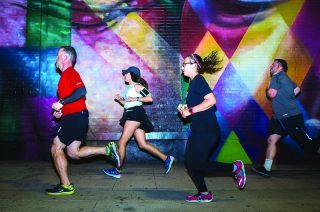
Street art is the destination as well as the scenery along the way on BlacklistLA's runs. Photo: Erik Valiente
Out on the impeccably neat plaza of the Walt Disney Concert Hall in downtown Los Angeles, home to one of the world’s finest orchestras, hip-hop is booming out of a nearby speaker. A few runners are here, doing those things runners do while they wait: stretch, sip water, sit around, adjust their phone holders. It’s about the only thing going on as far as you can see—by 9:30 p.m., this corner of downtown in this famously car-choked city is dead still. But every minute, dozens of more runners keep materializing like a flash mob: sometimes alone, sometimes in pairs or groups.
Soon there will be hundreds here on this warm spring Monday night, all here to run together through a sleeping city.
This is not a race, but there is a destination: a very, very large mural a couple miles away. It’s the two things this running group that calls itself BlacklistLA was founded upon—running and street art—and it’s caught fire.
Two years ago, there were 11 people on the group’s first run. Tonight there are easily 200. Some of the weekly Monday evening runs draw more than 300. It’s not hard to see why: This urban running adventure gives people a reason to look forward to Mondays, to meet other people, and to explore the many hidden corners of this massive city on foot.
“We always say that they show up for the art, but they stay and continue to show up for the community,” says Erik Valiente, the friendly, cherubic-faced founder of BlacklistLA, who rides up on a 10-speed with a messenger backpack from which hangs a big camera with a giant flash. In addition to the thrill of running together at night, it’s the evening timing—with less traffic and many people off of work—that makes such a large gathering possible.
As group running with a social bent continues to grow around all kinds of lifestyle pursuits—beer, tourism, dating—art may at first seem like an unlikely pairing. But it’s not. “It’s part of the experience of an urban runner,” says renowned art dealer Jeffrey Deitch, an avid runner himself, about street art. “Often, this is people’s first experience with ambitious artwork.”
And as running groups go, BlacklistLA seems to do everything right to cater to a 21st century runner’s needs and desires: It turns exercise into a shared experience; offers a chance to explore the city, with great Instagram opportunities; plus Valiente posts a bunch of ready-to-share photos of runners by the time they wake up on Tuesday. It seems to touch on many of the Millennial generation’s stereotypes.
But the hundreds that show up aren’t all in their 20s. There are people of all colors, males and females (though far more guys), newbie runners and chiseled marathoners. Even the dogs, maybe 10 or so brought along by their owners, are diverse—from silky-furred lap dogs to eager-looking pit bulls. And while Valiente and his co-founders are Los Angeles natives, I meet a guy from Canada who just moved to the city today. He’s out here tonight to meet people.
In fact, for Valiente, this is the entire point of BlacklistLA: A chance for Angelenos to better know their city, as well as each other.
Valiente used to drive to his job as a teller at a Chase bank. While it paid the bills, he was left unsatisfied with the experience—at least the thought of doing it for the rest of his life. He was already running, having signed up for and completing the LA Marathon in 2007 for the first time on a bet (he’s run it every year since then). He tried to start a running club in his neighborhood of Harvard Heights, just west of downtown, but without some kind of hook beyond exercise to draw people out every week, it didn’t last long. But he had the desire to build a community. “The only way I knew how to do that was through running,” he says.
And so he landed a job at Nike’s running store at The Grove, where he spent some of that time as a coordinator for the Swoosh’s nascent Nike+ Run Club program.
“Erik was really successful at that,” says Jerome Rideaux, Valiente’s former co-worker at Nike. “He had so many ideas and wanted to do so many different things. But when you’re under Nike you’ve got to get it past them, and he just wanted to do his own thing.”
Rideaux remembers having dinner with his Nike store co-workers when Valiente unveiled his plan for a new running group. By then Valiente had ditched his car and was getting around the city on bike, and with this freedom he started taking a bigger interest in all the street art around L.A.—and now he could freely take photos of it all. People who followed him on Instagram always wanted to know where all this artwork was. He didn’t want to just tell them where to go, because where’s the fun in that? So his initial plan was to show people around via bike tours, but that quickly fizzled out when he realized that many of his friends didn’t have bicycles.
“Then a light bulb popped into my head,” Valiente says. “I thought, why don’t we just run?”
And so they did. There were 11 people. “We all fit in the photo,” Rideaux says with a laugh. Valiente called this group “Blacklist” in honor of street artists, because their work is often blacklisted and eventually painted over. In fact, the art’s impermanence also gave the group’s runs an immediacy. But the true genius was Valiente’s photo duties: He would take photos of everyone on the run then send everyone a Dropbox link to these photos later that night. Word about BlacklistLA soon spread through social media.
Before Valiente knew it, he started arriving each week to several hundred people, as there are tonight, all amped up on music for a collective run through the city. The group’s Instagram feed now has more than 16,000 followers.
“It’s growing so quickly and so fast that, you know when they say be careful what you wish for?” Valiente says, half joking. “Now it’s like, oh shit, OK … we’re doing this! That keeps me up at night, but these are good problems.”
He quickly realized the need for help in keeping even a cheerful crowd lawful and under control, and so BlacklistLA cultivated a small volunteer army of pacers. They’re known as PulseKeepers, and each is outfitted with a glowing wrist or ankle bracelet and a handheld boom box to identify themselves and add a bit of ambiance.
Several minutes before 10 p.m., as the big stereo keeps on playing and everyone else is stretching or talking inside this now full plaza, Valiente is in a corner, huddling in a circle with the PulseKeepers, going over the route and any dangerous sections, sharing info about the artist in case runners ask, congratulating certain volunteers for particular jobs well done and going over BlacklistLA’s other events for the week.
The post Discovering Los Angeles Street Art on the Run appeared first on Competitor.com.
Could Pokémon Go Be The Future of Running?

Photo: Shutterstock.com
A new craze has hit the running world and, believe it or not, it doesn’t involve getting a race T-shirt, a finisher’s medal or even paying an entry fee.
Yes, Pokémon Go might seem like the latest smartphone app game craze due to its ’90s kid nostalgia of the original collectible trading cards and TV series—and it definitely is—but it’s also much more than that. It’s arguably the first virtual creation that transcends the digital domain and brings a next-level, fitness-enhanced gamification to the great outdoors—namely roads, bike paths, trails and parks—especially if you’re a runner.
Currently, it is only available throughout North America and Europe, but on July 20 the app will launch in Japan, the birthplace of Pokémon, and spark the start of a worldwide takeover.
If you haven’t played it yet, Pokémon Go is a free app-based augmented reality game from Niantic (available on Android and iOS devices) that entails finding, capturing, training and battling a variety of virtual geo-targeted Pokémon critters against a backdrop of real-life scenery. In other words, you can only see the cartoonish creatures through the app on your smartphone or tablet screen, but with use of your device’s camera lens and GPS coordinates, the app makes Pokémon seemingly come to life wherever you go.
Here’s the thing, though: If you’re a runner, you can advance through the levels of the game faster—basically you can cover more ground with your Pokémon avatar and get to PokéStops (notable real-world features like a statue, park bench or a waterfall) and collect Pokémon more quickly by running instead of walking—although there is a distinct danger when running while mostly looking down at your phone. (If you’re playing the game out on the run—or even walking—by all means, be careful! And We highly discourage playing while riding a bike or driving!)
Seriously, though, you could go for a two-hour run and play the game the entire time, so long as you could stay off traffic and avoid bikes and pedestrians. There are numerous crowd-sourced web-based maps that point out where the rare Pokémon are located, and those can be a helpful resource when planning a Pokémon-infused long training run.
For better or for worse, think of what could emerge by integrating Pokémon Go into running:
Races that not only encourage runners to play the game during a run, but actually design courses based on where eggs, balls and Pokémon are located.
KOMs on Strava leaderboards based on Poké points.
Virtual trail running adventures that create newfangled FKTs (Fastest Known Times) on some of the world’s iconic mountains and trails.
A Pokémon-enhanced rim-to-rim-to-rim run of the Grand Canyon.
New track & field events that require running, jumping, hurdling and throwing while also capturing virtual critters.
The opportunity to get young kids involved in running with fun, game-oriented fitness intervals
Whether or not it’s the future of running, it certainly seems to be at the tipping point of what’s next in the ever-blending realms of wearable technology, GPS data, augmented reality gaming and fitness, recreation and adventure.
The post Could Pokémon Go Be The Future of Running? appeared first on Competitor.com.
Video: Time-Lapse Glimpse of Rock ‘n’ Roll Las Vegas Half Marathon
Every year, Las Vegas Boulevard, aka, the Las Vegas Strip, is closed to vehicle traffic for only two occasions: 1) The city’s epic New Year’s Eve celebration, and 2) The Rock ‘n’ Roll Las Vegas 10K, half marathon and marathon races. Check out this 26-second time-lapse video from last year’s event that shows heavy traffic at 11 a.m., road closures and finish line set-up starting at noon, more than 35,000 runners crossing the finish line between 4:45 p.m. and 10:30 p.m. and, finally, The Strip re-opening just before midnight after everything is packed up and put away while all the runners are out celebrating their success. This year’s race weekend is scheduled for Nov. 12-13 with a new out-of-this world finisher’s medal for every runner who reaches the finish line.
The post Video: Time-Lapse Glimpse of Rock ‘n’ Roll Las Vegas Half Marathon appeared first on Competitor.com.
Team USA Minnesota Searching for New Head Coach
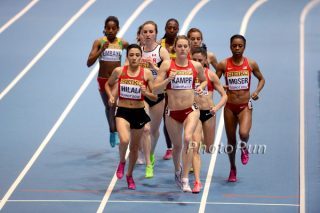
Outgoing team USA Minnesota coach Dennis Barker has helped guide numerous athletes to national and world championships during the past 15 years, including Heather Kampf. Photo: PhotoRun.net
Team USA Minnesota has some big shoes to fill.
The post-collegiate training group for professional distance runners based in Minneapolis/St. Paul has begun a search for a new head coach. The position is available given the resignation this month of its long-time coach, Dennis Barker.
Since 2001, the group has developed an Olympian and 24 national champions in distances that include the 1500m, 3000m, and 10,000m on the track; mile, 10K, 15K, half marathon, 25K and marathon on the roads; and 4K, 8K and 10K cross country. It has also achieved 74 top three finishes in U.S. Championship events and placed athletes on 28 world teams.
“We appreciate all that Coach Barker has done for our distance runners over the past 15 years and four Olympic cycles,” said Pat Goodwin, founder and president of Team USA Minnesota. “We certainly wish him well with the next stage of his career.”
The team’s head coach recruits, develops and manages 10 to 12 male and female elite distance runners on the track, cross country and roads. The group’s focus is to prepare athletes to compete at national and international championships and competitions, along with major races and sponsorship events.
“This is the perfect timing for a new coach to come on board and further develop a roster that will be even more competitive in this next Olympic cycle,” Goodwin said. “It is a great opportunity in an amazing training environment.”
Team USA Minnesota has a 14-member Board of Directors who have extensive ties in the running community. The team also has a network of health care resources, a number of supportive sponsors and contributors, and access to a range of training facilities, tracks, trails and running paths. In addition, the group has an active community involvement program. Team USA Minnesota has twice received the Running USA Allan Steinfeld Development Award (2010 and 2015) as one of the best developmental training groups in the country.
The deadline to apply for the head coach position is July 29 with a start date of Sept. 1. To request a job description or to obtain more information, contact Pat Goodwin at 952-454-8876 or e-mail pfgoodwin@teamusaminnesota.org.
The post Team USA Minnesota Searching for New Head Coach appeared first on Competitor.com.
July 18, 2016
Karl Meltzer Once Again Sets Sights on Appalachian Trail FKT
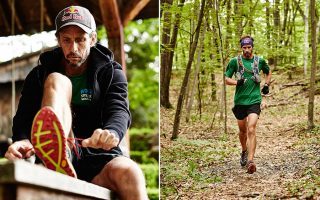
In August and September, Karl Meltzer will attempt to cover the 2,189 miles of the Appalachian Trail in less than 46 hours, 8 hours and 7 minutes. Photo: Josh Campbell/Red Bull Content Pool
Few runners have endured long miles the way Karl Meltzer has. The winningest 100-mile runner in history—he’s won 38 of ‘em—the resident of Sandy, Utah, has earned plenty of hardware and battle scars in his 20 years in the sport.
As a runner, coach and race director, Meltzer, whose nickname is “Speedgoat,” has achieved an enormous bounty of success. He’s won 57 ultra-distance races, including the daunting Hardrock 100 in Colorado a record five times. He’s also played a world record 230 holes of golf in 12 hours and covered the entire Pony Express Trail (2,064 miles) on foot in 2010.
Now the 48-year-old trail running legend is going after one of the few things he’s been unsuccessful at twice—achieving the fastest known time (FKT) on the Appalachian Trail. In early August, Meltzer will begin his quest on the 2,189-mile trail from Mt. Katahdin, Maine, and run, trek, hike and walk all the way to Springer Mountain, Georgia.
His goal will be to break Scott Jurek’s 2015 record of 46 days, 8 hours, 7 minutes. It’s a record he helped Jurek achieve as a support runner last summer, and Jurek will do the same for Meltzer this summer. (Jurek covered the trail from south to north between late May and early July last year.)
RELATED: Scott Jurek Sets New FKT for Appalachian Trail
Meltzer, a Red Bull and Hoka One One athlete, will have to average more than 50 miles per day to achieve the record. (Red Bull has created a multimedia page that will monitor his progress.) But he knows first-hand what it will take. In addition to being on the trail last year with Jurek, Meltzer first attempted to break the record in 2008 but came up just short—finishing in 54 days, 21 hours, 12 minutes. (At the time, the record was 47 days, 13 hours, and 31 minutes.) He also attempted it in 2014 but stopped after about 1,500 miles when he fell off pace and wasn’t doing well physically or mentally.
“I’m going to give it one more try. Hopefully the third time will be a charm,” Meltzer told Competitor.com. “I was planning to go back this year before Scott did it last year. I’ve done all my homework and recon and hopefully the stars will align this time around.”
RELATED: Inside the FKT (Fastest Known Time) Trend
Meltzer was part of Jurek’s small crew of supporters last year. In addition to Scott and Jenny Jurek, Meltzer will be supported at various points on the trail by his 74-year-old dad, Karl Meltzer, his wife, Cheryl, and friends Eric Belz and Mike Mason. Meltzer will be taking 15 pairs of Hoka Speedgoat shoes with him (it’s the sticky rubber mountain running shoe built especially for him), plus a few pairs of Hoka Challenger ATR 2.
“I think what makes the Appalachian Trail unique is that there is a certain vibe on it,” Meltzer said. “When you walk on the AT or go for a long run on it, it’s like you’re in a long green tunnel. You can just feel the aura when you’re out there.
“What Scott went through was very inspirational,” Meltzer said. “Hopefully I can bring some of that energy into my attempt.”
RELATED: Summer of Speed—2015’s Top Trail Running FKT Marks
The post Karl Meltzer Once Again Sets Sights on Appalachian Trail FKT appeared first on Competitor.com.
Ryan Hall's Blog
- Ryan Hall's profile
- 21 followers



